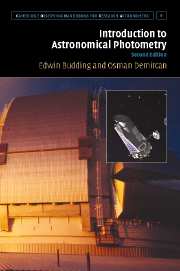Book contents
- Frontmatter
- Contents
- Preface to first edition
- Preface to second edition
- 1 Overview
- 2 Introduction
- 3 Underlying essentials
- 4 Themes of astronomical photometry
- 5 Practicalities
- 6 Procedures
- 7 Basic light curve analysis
- 8 Period changes in variable stars
- 9 Close binary systems
- 10 Spotted stars
- 11 Pulsating stars
- Appendix
- Author index
- Subject index
8 - Period changes in variable stars
Published online by Cambridge University Press: 13 August 2009
- Frontmatter
- Contents
- Preface to first edition
- Preface to second edition
- 1 Overview
- 2 Introduction
- 3 Underlying essentials
- 4 Themes of astronomical photometry
- 5 Practicalities
- 6 Procedures
- 7 Basic light curve analysis
- 8 Period changes in variable stars
- 9 Close binary systems
- 10 Spotted stars
- 11 Pulsating stars
- Appendix
- Author index
- Subject index
Summary
Variable stars and periodic effects
The times of observed features, usually minima or maxima, on the light curves of variable stars (single or binary), can often be accurately determined. Many classes of variable star have a repetitive, cyclic behaviour regarding such features and time, which is understood in terms of their basic physical properties. Thus, timing data are applied to measuring rotation, pulsation, or orbital periods (P) of the different kinds of variable. It follows from angular momentum considerations that any change in the velocity field and/or mass distribution within or nearby a star, or binary system component, will cause a change in rotational or orbital motion. There will then result shifts of corresponding minima (or maxima) times that have relevance to physical changes of the object in question. The ‘O – C’ method is commonly used in measuring shifts in the observed times of photometric features.
The O – C method
Defining terms: The O – C – ‘observed minus calculated’ datum (regarded as a single item) – indicates any time difference between the epoch of an observed phenomenon, presumed periodic, and its prediction, based on an ephemeris formula. Eclipses are a typical example. In this case, O – C analysis often allows identification of the possible cause of period variation. These may arise from orbital eccentricity effects, mass loss from the system or exchange between the components, magnetic effects, the presence of a third body or other reasons.
The normal unit of time for this context is heliocentric Julian days.
- Type
- Chapter
- Information
- Introduction to Astronomical Photometry , pp. 279 - 309Publisher: Cambridge University PressPrint publication year: 2007



